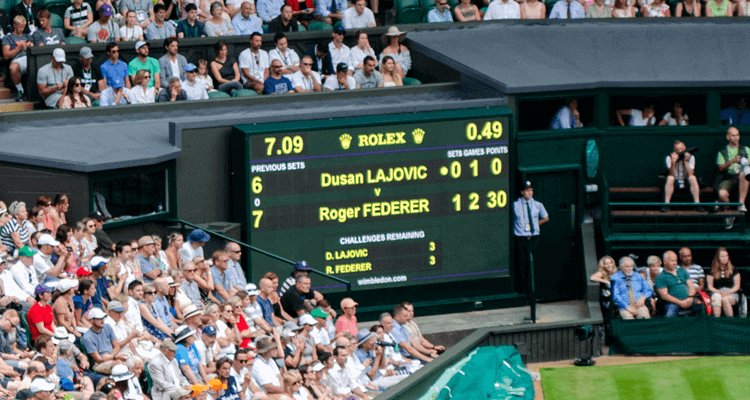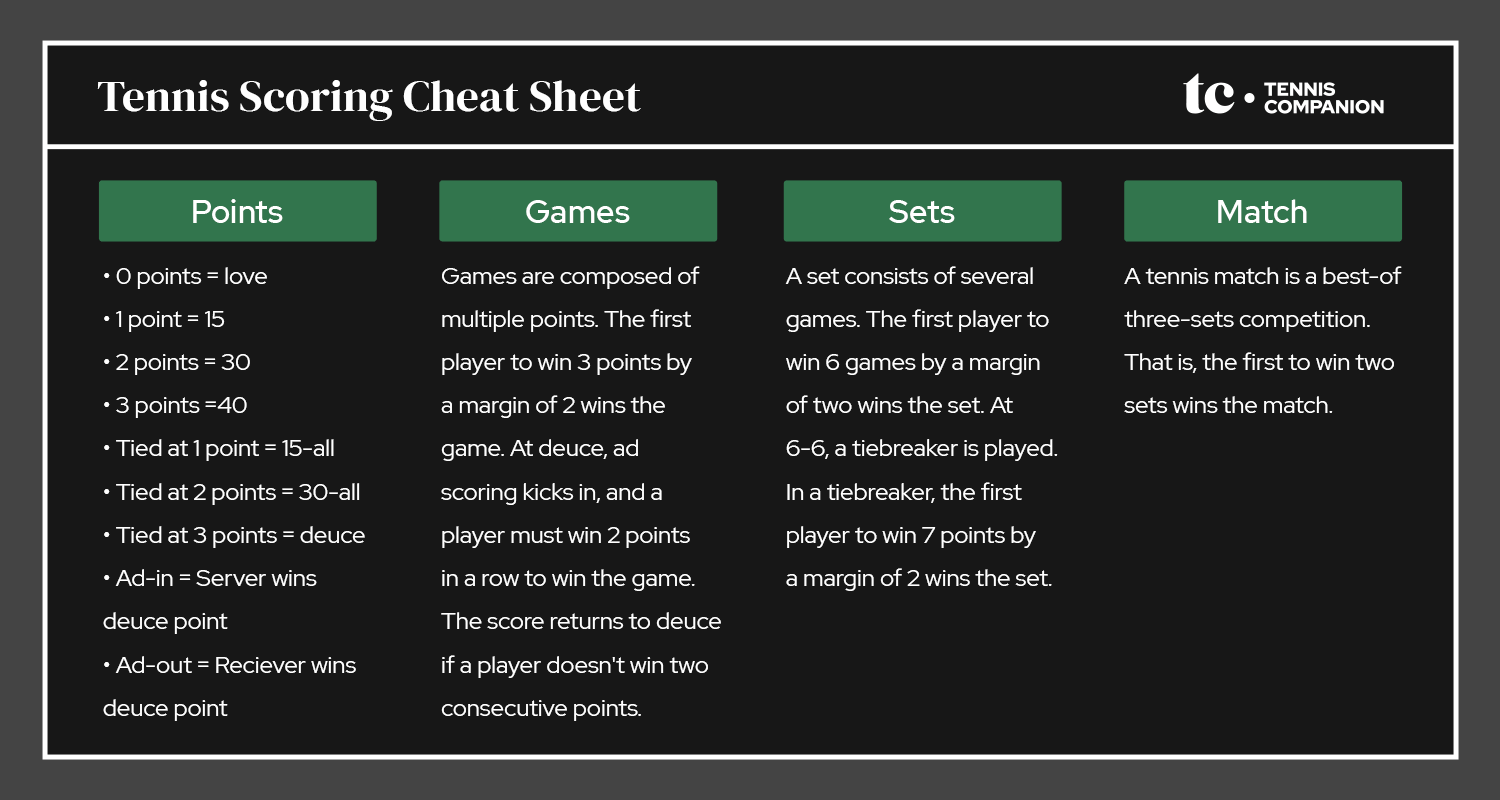Check out my custom vibration dampener
Tennis Scoring Simplified
Point System + How to Keep Score
Less than intuitive, the tennis scoring system is one of the most unique in sports, which unfortunately adds an unnecessary layer of complexity when learning to play or enjoying a match as a casual fan.
Thankfully, what appears confusing on the surface is relatively straightforward once you understand the basic structure of a match and the terms that make up the point system.
In this guide, I’ll help you learn how to keep score in tennis by breaking down the scoring system into easy-to-digest pieces and clearly explaining the intricacies so you can confidently play or watch a match.
Article Contents
Click below to jump to a section
Tap below to jump to a section
Basic Match Structure
Point Values
How to Start a Match
Grand Slam Scoring
Scoring Variations
History of Scoring
New to TennisCompanion?
Create a free account and explore my latest videos below
Cheat Sheet
To help simplify the scoring system for tennis, I created the following cheat sheet that covers the highlights.
You can click the cheat sheet to view it full-screen and take a screenshot, or you can tap and hold the image and save it to your phone to bring it with you for quick reference.
Keep reading for a detailed overview of the scoring system, which will explain all the nuances in greater detail.
Basic Match Structure
Before diving into the point system, it’s helpful to understand the basic structure of a tennis match, including sets, games, and points. Here’s the hierarchy that exists between these elements.
- Match: Consists of multiple sets
- Set: Consists of several games
- Game: Consists of many points
- Point: A single unit of play
I’ll cover each separately, and then we’ll review the point system.
Set
At the highest level, a tennis match consists of multiple sets. In professional and recreational tennis, the most common format is best of three, meaning the first player to win two sets wins.
In rare cases, such as Grand Slam singles matches for men, the format is best of five, so the first player to three sets wins. The four Grand Slam tournaments that use best-of-five set scoring are as follows:
- Australian Open
- French Open
- Wimbledon
- US Open
There are two types of sets: advantage and tiebreak. I’ll cover these, along with games, in the following section.
Games
You must win six games by a margin of two to win a set. For example, you would win a set if you reach six games when your opponent has four. In that case, the final score for the set is 6-4.
What happens when you and your opponent reach 6-6 depends on the type of set you’re playing: advantage or tiebreak.
Advantage Set
In an advantage set, play continues until one player is ahead by two games. For example, if you win the next two games after reaching 6-6, you’d win the set 8-6. However, an advantage set can continue significantly longer because one player has to win by a margin of two.
That happened in the longest tennis match ever, where John Isner defeated Nicholas Mahut at Wimbledon with a final set score of 70-68.
Historically, advantage sets were common. However, the sport has moved away from them because they often take too long to complete.
Tiebreak Set
The sport introduced tiebreak sets to help speed up matches, which are better at holding the attention of fans and more appropriate for TV.
In a tiebreak set, the goal is still to reach six games first by a margin of two. However, if the score arrives at 6-6 in games, you play a tiebreaker instead of having to win by two games. The following point system section will cover how to score a tiebreaker.
Points
Every point begins with one player serving. A point concludes whenever any of the following happens.
- A player misses two serves in a row, called a double fault.
- A player’s shot lands out of bounds.
- A player’s shot hits the net and doesn’t go over it.
- A player hits a shot within bounds of their opponent’s side of the court that they can’t reach, called a winner. On a serve, it’s an ace.
- A player hits a shot within bounds of their opponent’s side of the court that bounces twice before they can reach it.
- A player receives a point penalty.
Now that we’ve covered what sets, games, and points are and how they fit into the context of a tennis match, let’s dive into the point system and how to score a game in tennis.
Point System
Some of the most frequent questions I get about scoring in tennis relate to the point system or how you score a game. The following are the terms players use for points and their values.
- 0 points = Love
- 1 point = 15
- 2 points = 30
- 3 points = 40
If you win the first two points while serving a game and your opponent wins the third one, the score would be 30-15 and called out accordingly. However, when the score is tied, the score is called as follows.
- Tied at 1 point = 15-all
- Tied at 2 points = 30-all
- Tied at 3 points = Deuce
The first player to win three points wins the game, except when tied at three points, which we call deuce, not 40-all.
Deuce & Advantage (Ad) Scoring
Beyond a tie score of three points, deuce refers to the start of advantage scoring, where a player must win two consecutive points to win the game.
When a player wins a point at deuce, they gain the advantage. However, instead of saying “advantage” when calling out the score, we abbreviate it to “ad.” Here are the terms used in ad scoring.
- Ad-in = Server wins the point at deuce
- Ad-out = Returner wins the point at deuce
If the player who holds the advantage doesn’t win the next point and subsequently the game, the score returns to deuce. For example, if you won the first point at deuce while serving, the score would be “ad-in.” If you lose the next point, the score returns to “deuce.”
The score bounces back to deuce as many times as it takes for a player to win two consecutive points, at which time the game concludes.
Helpful Tip
Since an umpire calls out the score in a professional match, they state who has the advantage. For example, you might hear “advantage Federer” or “advantage Williams.”
Scoring an Example Game
To help paint a clearer picture, let’s run through a hypothetical game where you’re serving.
| Point Result | You | Your Opponent | You Call Out |
| Your opponent wins the point | Love | 15 | Love-15 |
| You win the point | 15 | 15 | 15-All |
| You win the point | 30 | 15 | 30-15 |
| You win the point | 40 | 15 | 40-15 |
| Your opponent wins the point | 40 | 30 | 40-30 |
| Your opponent wins the point | 40 | 40 | Deuce |
| You win the point | Advantage | 40 | Ad-In |
| Your opponent wins the point | 40 | 40 | Deuce |
| Your opponent wins the point | 40 | Advantage | Ad-Out |
| You win the point | 40 | 40 | Deuce |
| You win the point | Advantage | 40 | Ad-In |
| You win the point/game | Win a Game | Next to Serve | n/a |
Remember, the server always calls their score out first.
Tiebreakers
If you’re playing a tiebreak set, a tiebreaker commences when the score reaches 6-6. A typical tiebreaker is a game played to the best of seven or the first player to win seven points by a margin of two.
However, a tiebreaker forgoes the quirky scoring of a typical game and instead uses simple point values, i.e., 0, 1, 2, 3, 4, etc.
Instead of one player serving for the entire tiebreaker, players alternate when the total points are odd. Furthermore, the server who was due to serve starts the tiebreak game from the deuce or right side of the court, and players change ends every six points.
For example, if your opponent is the last player to serve when the score reaches 6-6, you’d start serving the tiebreaker. After serving the first point, your opponent would serve for two, and you’d continue alternating until the conclusion of the tiebreaker. Then, when the score reaches six points, you’d switch ends, repeating until one player wins seven points by a margin of two.
Another type of tiebreaker is the 10-point tiebreak. Instead of best of seven, players compete to a best of ten points by a margin of two. If players reach 6-6 in the final set of any Grand Slam tournament, they play a 10-point tiebreaker, adding to the excitement of the match.
Due to the nature of tiebreakers, scores periodically reach higher numbers, e.g., 20-20, because a player has to win by two.
Score Keepers
Score keepers are an excellent way to help reinforce how to keep score and prevent you from forgetting it, which happens more often than you might expect in competitive matches.
The three main types of score keepers for tennis include net, racquet, and wristband. Here are a few of my favorites.
- Match Tuff Score Cards: Flip cards rest on the net.
- Scoring Right: Adheres to the throat of your racquet.
- Skorkeep: Vibration dampener that keeps score.
- ScoreBand: Wear it on your wrist like a watch.
Each product tackles keeping score differently, but all are practical solutions that help players accurately keep score.
How to Start a Match
A match begins by determining which player should serve first, which should happen before players start warming up.
Who Serves First
One player spins their racquet, allowing it to fall to the ground, and the other calls up or down. In the case of a Wilson racquet, when the logo on the butt cap lands on “W,” it’s up, and when it lands on “M,” it’s down. Alternatively, players can flip a coin if they have one in their bag.
The player who wins the racquet spin or coin toss chooses to:
- Serve or receive
- A side of the court
- Defers to their opponent
If you defer the decision to your opponent, they cannot defer back. If you decide to serve or receive, your opponent chooses a side of the court or the other way around.
Helpful Tip
In a professional tennis match, the umpire flips a coin to determine who serves and receives first. However, no rule specifies which player the ump should ask to call the coin flip – it’s their call.
Switching Ends of the Court
During a set, players switch ends of the court every odd game. Therefore, after the first game, players switch sides, then alternate every two games.
During a tiebreaker, players switch ends every six points.
Announcing the Score
Throughout a match, the server always calls out their score first. Players should call the score out after every point during a game, at the start of a new game, or set to ensure accurate scorekeeping.
Shaking Hands
At the end of a match, players should meet at the net to shake hands. It’s good sportsmanship and tennis etiquette.
Scoring Variations
Although scoring in tennis has remained relatively unchanged, a few alternative scoring methods have surfaced in recent years, all of which aim to increase a match’s speed and entertainment value.
No-Ad Scoring
Typically, when the score reaches 40-40 or deuce in a game, advantage scoring kicks in, and a player must win by two points to win the game.
With no-ad scoring, the next player to win a point at 40-40 wins the game, removing the back and forth that can happen with the requirement of a player winning by a margin of two.
You’ll find this format in use at all levels of the game, and it’s one of the most effective ways to speed up a match.
10-Point Tiebreakers
A 10-point tiebreaker works the same way as a 7-point tiebreaker, except the first to 10 points by a margin of two wins instead of seven.
The most common use of 10-point tiebreakers is for doubles, where they often replace the third and final set of a match. In Grand Slam events, 10-point tiebreakers also replace seven-point tiebreaks in the last set of men’s and women’s singles matches.
Other terms for 10-point tiebreakers include championship or super tiebreak, alluding to the higher number of points players must win.
Fast4 Tennis
Fast4 Tennis is a scoring format originating in Australia, with three key distinctions from standard scoring.
- Players win a set when they reach four games by a margin of two, with a tiebreak when the score in games ties at 3-3.
- All games use no-ad scoring. When players tie at 40-40, the next to win a point wins the game.
- Instead of a final third or fifth set (depending on the format), players compete in a 10-point tiebreaker.
Some professional exhibition matches have used the Fast4 match and scoring format, but the ATP & WTA do not use it. Otherwise, it’s a practical way to speed up matches for club and recreational play.
Grand Slam Scoring
Scoring at the Grand Slam tournaments, including the Australian Open, Roland Garros, Wimbledon, and the US Open, is nearly identical to the scoring of a regular tennis match you’d play, with a few exceptions.
Best of Five Sets
Men’s singles matches at Grand Slam events are all played as best of five sets, meaning the first player to three wins the match.
All others, including men’s doubles, women’s singles, women’s doubles, and mixed doubles, are played as best of three sets.
Singles Final Set Tiebreakers
For all Grand Slam singles events, players who reach 6-6 play a standard 7-point tiebreaker, except for the final set. In that case, players compete in a 10-point tiebreaker.
In men’s singles, that means if players reach 6-6 in the fifth set, they play a 10-point tiebreaker. In women’s singles, players play a 10-point tiebreaker if the score is 6-6 in the third set.
For mixed doubles at Grand Slam tournaments, a 10-point tiebreaker replaces the third set altogether. The same holds for men’s and women’s doubles matches outside Grand Slam events.
Doubles No-Ad Scoring
In addition to using a 10-point tiebreaker for the third set, mixed doubles matches use no-ad scoring, meaning when a game reaches 40-40, the next team to win a point wins the game, forgoing advantage points.
Outside of Grand Slam events, men’s and women’s doubles also use no-ad scoring at all matches on the ATP & WTA tours.
Adjusting the rules to use 10-point tiebreakers as third sets and implementing no-ad scoring lend themselves to shorter matches, which is ideal for TV and may improve the entertainment value of matches.
Additional benefits include doubles players extending their careers because matches are less fatiguing and encouraging singles players to participate in doubles for the same reason.
History of Scoring
Although a few theories exist regarding the origin of scoring in tennis, there isn’t a definitive understanding of how it came to be.
Of course, that doesn’t stop fans from speculating. Here’s a look at the two most common views on the history of tennis scoring.
The Clock Face
If you do some digging, the most common theory you’ll run across is that early versions of the game had players keeping score with non-functioning clocks. After winning a point, a player would turn the minute hand a quarter of the way around to 15 minutes, then 30, 45, and 60 for the game’s completion.
Of course, 45 isn’t a point value, it’s 40, so proponents of this theory suggest that somewhere along the line, the score of 45 changed to 40, but the logic for the change isn’t clear.
Unfortunately for this theory, there are accounts of the tennis scoring system long before the introduction of minute markings on clocks, so it’s unlikely this theory is valid.
Real Tennis
Another theory regarding the origin of scoring in tennis ties to real tennis, one of the earliest forms of the sport played in France around the 12th century – there are two variations on this theory.
The first version involves the 14 lines of a traditional real tennis court. It’s thought that players may have used the point values of 15 to avoid confusion with the court lines, hence 15, 30, etc.
The other variation involves the length of the court, which is 90 feet or 45 feet on either side of the net. After winning a point, the server would advance 15 feet, then an additional 15 feet for each point they won, coinciding with the point values for keeping score.
However, if you dig deep enough, there’s reason to believe this theory misses the mark because the court length and markings weren’t consistent or standardized.
Perhaps new findings will help us better understand the origin of the tennis scoring system at some point. For now, we’ll have to appreciate the scoring system as is, regardless of the logic used to arrive at it.
Wrapping Up
Whether you’re new to the sport, attending a match, or looking for clarification, I hope this guide has helped shed some light on the sport’s scoring system, including how to keep score.
If you’re still struggling, I encourage you to stick with it. Keeping score will become second nature over time, and you won’t have to think twice about it when playing or watching a match.
Of course, if you have any questions about the scoring system, please don’t hesitate to post a question below in the comments.
Play Better Tennis
Improve your game alongside our community of tennis players
Why join?
Discussion Boards
Join the conversation with other members of the community.
5 Point Friday
Read our weekly recap of the 5 most interesting things we dig up in tennis.
Trackbacks & Pingbacks
Leave a Reply
Want to join the discussion?Feel free to contribute!




What age should you get your child started with playing tennis ?
Hi Joseph,
I cover this topic over here on my website. Check it out, and let me know if you have any follow-up questions.
All the best,
Jon
Please what is -2.5 and +2.5 in tennis match?
Hi Ola,
You’re referring to a handicap, which is often used in betting.
All the best,
Jon
I understand the scoring system.
I get confused when I see a fault on serve but I hear the umpire say
… ” first service ” … ” let ” …. ” second service ” and on and on until play resumes as normal without any loss of score to the guy who is serving !
Can you explain ?
Hi Joseph,
I’m not sure I’m following, but I’ll give it my best shot. When the umpire calls a let, the server’s serve hits the net and goes into the correct service box, so they get to serve again.
A let can be called on a second serve several times. In all cases, the server continues to serve until A.) the serve goes in, and the point is played, or B.) the serve goes out, and the serve loses the point by double fault.
Does that clear up the situation for you?
All the best,
Jon
when you serve the ball and have announced score first can your opponent stop play on their side because they think the score is wrong? The ball is in play, what do you do, serve over or take the point if you are the one calling the mistake?
Hi Deedee,
If this were to happen, you’d resume play at a score that counts all the points and games you agree upon with your opponent, replaying the disputed points/games.
It’s a frustrating situation, which is why it’s so crucial for the server to audibly call all points to avoid confusion.
All the best,
Jon
Can you win a set of tennis with less points than your oponent
Hi Dave,
That’s an excellent question! Yes, this is possible, and the same goes for a match. This situation sometimes happens during a super tight match.
For example, if you win a set 7-6 and never dropped a point in any of the games you won, you’d have won all your games in four points for a total of 24 points (6 x 4 = 28). Then, say your opponent won all of their games at deuce, and each time they reached deuce, they won the following two points to take each game; that’s five points per game for a total of 30 points (6 x 5 = 30).
From there, if you won the tiebreaker 7-5, you won’t have won the set with a total of 31 points (24 + 7 = 31), while they lost with 35 points (30 + 5 = 35). A famous example is the 2019 final between Federer and Djokovic, where Djokovic won the match with 204 points, while Federer won 218.
Federer was better in all of the above stats except for unforced errors.
I hope that helps!
All the best,
Jon
that was very helpful for a high school tennis class. i will refer back to this if i have to.
Thanks, Marin!
What happens if you call out the wrong score 15/30 when it was actually 30/15 and you serve and play out the point? Do you play it again or does the other team get that point no matter what?
Hi Jill,
Great question! In this situation, players count all points and games they agree upon and replay the disputed points/games. Of course, when these situations arise, you may need to get an official involved to move forward if the opponent isn’t willing to budge.
All the best,
Jon
Thank you. Wonderfully clear explanations. How about faults?
Hi Linda,
I’m glad you found it helpful. Each time a player serves for a point, they have two opportunities to hit the ball in the service box to start the point. A missed serve is called a fault. Two missed serves are a double fault, meaning the server loses the point. If it’s a game point, the server loses the game.
All the best,
Jon